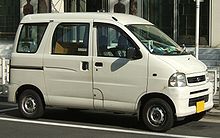This article has multiple issues. Please help improve it or discuss these issues on the talk page. (Learn how and when to remove these messages)
|

A microvan is a van or minivan which is within the Japanese kei car classification or similar, and is smaller than a mini MPV. In China, these vehicles are nicknamed miàn bāo chē ("bread-loaf vehicle") because of their shape. Similarly, in several Hispanic American countries, these vehicles are called pan de molde, which means "bread loaf". In Indonesia, it is commonly called a minibus due to their tall roof, perceived as resembling a miniature bus; the term is also used generally to refer to any type of three-row MPVs.
Outside of China and Japan, microvans are also common in Southeast Asia, South Asia, Africa, Latin America, and the Middle East. Microvans share similar characteristics with other-sized MPVs; for instance, microvans commonly have rear sliding doors. Generally, they have capacity for six, seven, or eight passengers. As this category of vehicle has fixed third-row seats, a single vehicle cannot be used both for passenger transport and larger-cargo transport without refitting; therefore, microvans are not usually considered multi-purpose vehicles.
Economics
Tax and insurance benefits in some locations make these models particularly inexpensive. For example, in rural Japan, kei-car vehicles are exempted from a certification that adequate parking is available for the vehicle. They are, therefore, widely used for small businesses in these places.
Design
The first vehicle to adopt the bodystyle of a van, with the engine installed in front of the driver, was the 1970s Honda Life "StepVan". Some microvans use a drivetrain with the engine installed transversely, using front- or all-wheel drive, while others use a cabover approach where the engine is installed beneath the driver, while still using all-wheel or rear-wheel drive powertrains. Cabover variants usually share their chassis with kei truck derivatives from the same manufacturer.
Most microvans have two swinging front doors, two sliding rear doors and a large tailgate. Seating can vary from two to nine; these seats are usually very thin and vertical to optimise room. The side windows in commercial-only versions of microvans are replaced by metallic panels; this type of microvan is sometimes called a "blind van". Some models also feature pick-up variants with one or two seat rows. Engines usually have displacements under 1.0 L; for example, Japanese microvans have a limit of 660 cc. Outside the Japanese market, microvans are available with 850-cc to 1.6-L engines.
The kei car regulation is used only in Japan, though other Asian automakers also design microvans with similar characteristics. The microvans are commonly known as "kei one-box" in Japan; their pick-up versions are known as kei trucks.
Gallery
Kei microvans
-
 Subaru Sambar Van sixth generation
Subaru Sambar Van sixth generation
-
 Honda Acty Van third generation
Honda Acty Van third generation
-
 Suzuki Every fifth generation
Suzuki Every fifth generation
-
 Mitsubishi Minicab Van fifth generation
Mitsubishi Minicab Van fifth generation
-
 Subaru Dias Wagon Classic food truck
Subaru Dias Wagon Classic food truck
-
 Maruti Suzuki Omni, Indian licensed version of the Suzuki Carry
Maruti Suzuki Omni, Indian licensed version of the Suzuki Carry
Non-kei microvans
-
 Suzuki Every Landy/E-RV or Maruti Versa
Suzuki Every Landy/E-RV or Maruti Versa
-
 Perodua Rusa Based on the Daihatsu Zebra.
Perodua Rusa Based on the Daihatsu Zebra.
-
Subaru Domingo second generation
-
Mitsubishi Town Box Wide
See also
References
- Chinese Hero Cars: The Mian Bao Che Archived 2008-10-11 at the Wayback Machine - China Car Times
- Nunn, Peter (January–February 2005). "Minicars: Cheap and Cheerful". JAMA. Retrieved 2012-05-10.